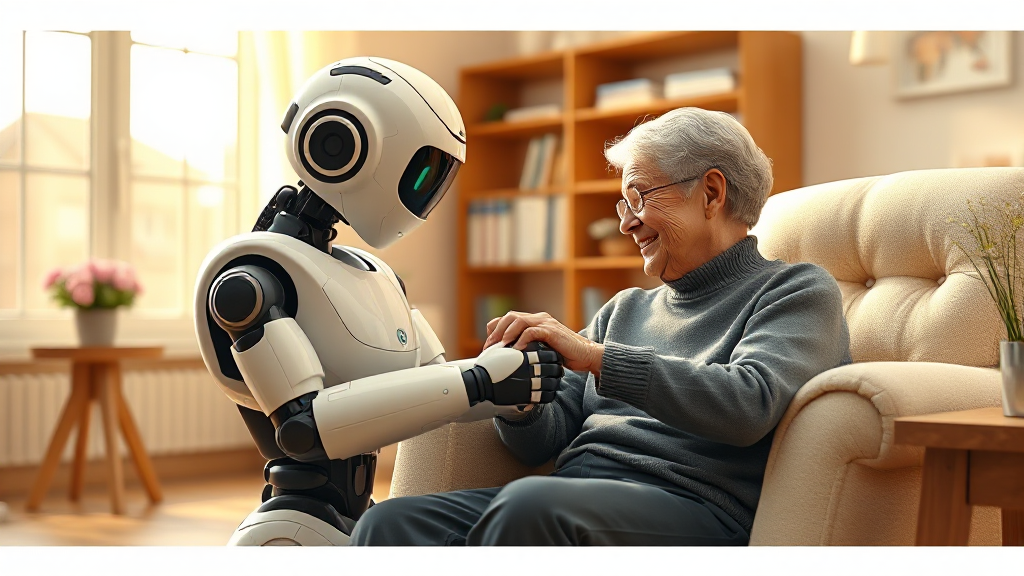How Robotics is Transforming Elderly Care at Home: A Comprehensive Guide

For a deeper dive, see our
.
This illustration highlights the role of robotics in providing companionship and support for elderly care at home, emphasizing trustworthiness and warmth.
Introduction
Caring for elderly family members can be a challenging task, often requiring significant time, effort, and emotional investment. As our population ages, the demand for innovative solutions powered by AI services to support elderly care has never been greater. One of the most promising advancements in this field is the integration of robotics controlled through mobile applications and web-based systems. This article explores how robotics is transforming elderly care at home, addressing key challenges, and offering insights into the benefits and practical applications of these technologies.
Understanding the Challenges of Elderly Care
The Physical and Emotional Strain on Caregivers
Caregiving for elderly relatives can be physically demanding. Activities such as lifting, assisting with mobility, and managing daily tasks often lead to burnout. Additionally, caregivers frequently face emotional challenges, including sleep deprivation and feelings of isolation.
Time Constraints and Limited Support
Modern lifestyles leave little time for caregiving responsibilities. Many families rely on working adults who have limited availability to provide constant care, creating a gap in support that robotics can help bridge.
The Benefits of Robotics in Elderly Care
Enhancing Safety and Security
Robotic technologies powered by AI services, such as wearable devices and smart home systems, monitor vital signs and detect falls, providing immediate assistance through alarms or alerts via mobile apps to family members or healthcare providers.
Promoting Independence and Quality of Life
By automating routine tasks like meal preparation, medication reminders, and housekeeping through AI-powered systems, robots enable elderly individuals to maintain their independence while reducing the burden on caregivers. These technologies, often managed via mobile applications and web interfaces, also provide companionship, combating loneliness and improving mental well-being.
How Robotics Work in Elderly Care
Types of Robotic Solutions
-
Monitoring Systems:
Devices like smartwatches track health metrics and detect anomalies, ensuring timely medical intervention.
-
Mobility Aids:
Exoskeletons and wheelchairs with advanced navigation features assist individuals with mobility challenges.
-
Interactive Companions:
Social robots provide companionship, engaging users in conversation or entertainment to reduce isolation.
Choosing the Right Robotic Solution
Factors to Consider
-
Medical Needs:
Evaluate specific health conditions to determine suitable devices.
-
Level of Care Required:
Match the technology's capabilities with the individual's needs.
-
Budget Constraints:
Explore options within financial limits while ensuring quality and safety.
-
Ease of Use:
Opt for user-friendly systems that minimize learning curves.
Addressing Concerns About Robotics
Privacy and Security
Connected devices raise privacy concerns. It is crucial to discuss settings with users and ensure data security measures are in place.
Cost Considerations
While some technologies may be expensive, government programs or insurance policies can offer financial assistance.
Learning Curve for Caregivers and Elderly Users
Educating both caregivers and users about device operation through training sessions is essential.
Looking Ahead: Future Trends in Elderly Care Robotics
Innovations to Expect
-
AI Integration:
Enhanced decision-making capabilities for monitoring systems.
-
Affordable Solutions:
More accessible technologies for broader adoption.
-
Wider Adoption:
Increased availability of robots across diverse demographics.
Conclusion
Ready to take the next step?
.
Robotics is revolutionizing elderly care by addressing challenges and enhancing quality of life. As these technologies evolve, they offer promising solutions to support both caregivers and their loved ones. Consider consulting healthcare providers to identify the best robotic solutions for individual needs and explore how robotics can make a difference in your home.
Related Articles
Why EifaSoft Stands Out in MLM Software Development: A Comprehensive Guide
Discover what sets EifaSoft apart in MLM software development. Get a comprehensive guide to the latest innovations, including AI-driven insights and dynamic dat
Why Custom MLM Software Development is Critical for Modern Businesses
Discover why custom MLM software development is crucial for modern businesses. Learn how advanced blockchain technology provides a secure shield for your multi-
Why Choosing the Right MLM Software Development Company is Crucial for Your Business Success
Here is a concise and compelling SEO meta description for your blog post: Discover why choosing the right MLM software development company is crucial to your b